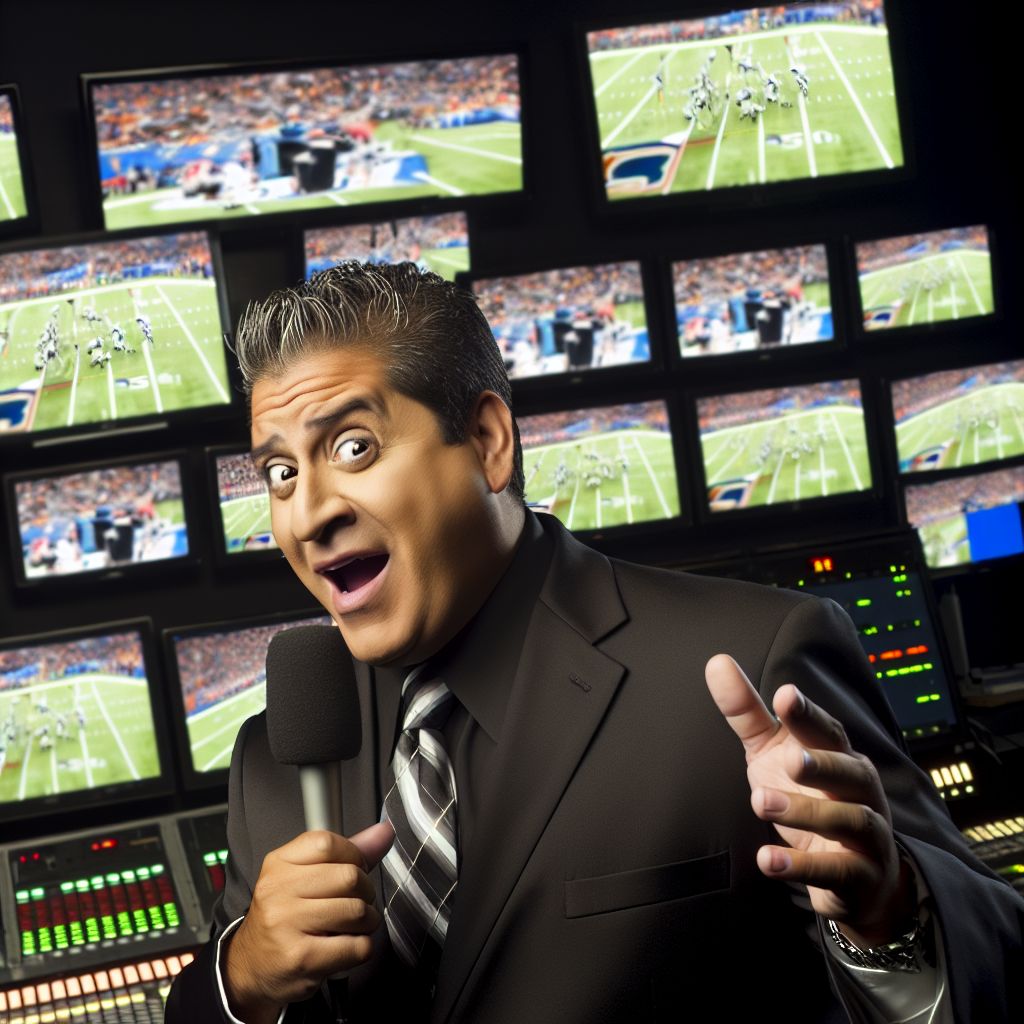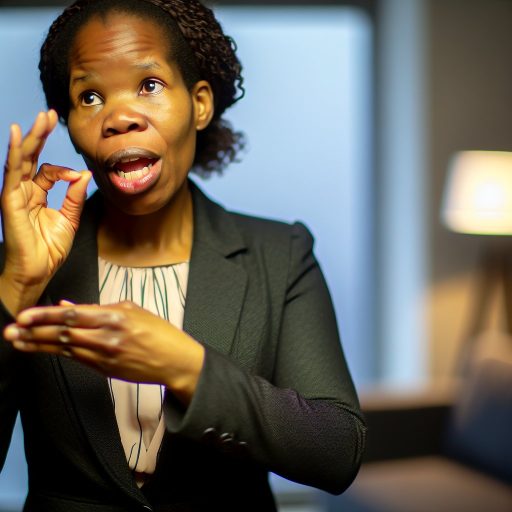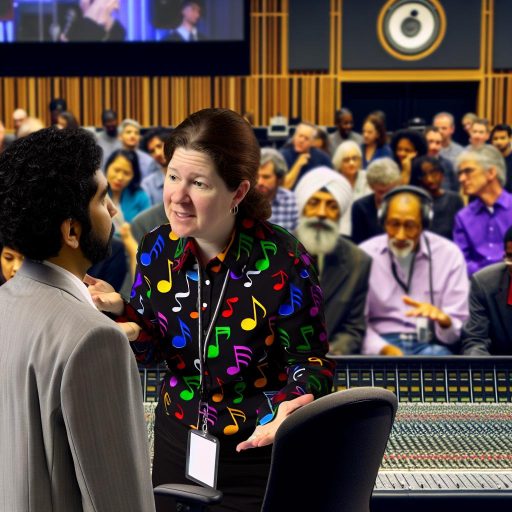Introduction
Sports announcing serves to communicate and enhance athletic events.
Announcers provide play-by-play commentary and insightful analysis.
Their voices guide viewers through games, creating excitement and engagement.
In recent years, we have witnessed a significant increase in the presence of women in sports announcing.
More female voices are breaking through traditional barriers.
This shift enriches the landscape of sports media.
Women bring unique perspectives and experiences to the microphone.
The purpose of this blog post is to explore the challenges and triumphs faced by women in this field.
We will highlight the hurdles they overcome daily.
Additionally, we will celebrate their successes and contributions to sports broadcasting.
Historical Overview of Women in Sports Announcing
The journey of women in sports announcing spans decades.
It reflects an evolution characterized by significant changes, milestones, and challenges.
This narrative highlights early pioneers, key achievements, and obstacles faced along the way.
Evolution of Women in Sports Announcing
The evolution of women in sports announcing traces back to the early 20th century.
Initially, the sports world primarily featured male voices.
Women seldom received opportunities to showcase their talents.
However, societal changes began to alter this narrative.
As the feminist movements gained momentum in the 1960s and 1970s, women sought recognition in traditionally male-dominated fields.
This included sports announcing.
Their determination opened doors previously thought closed.
Transform Your Career Today
Unlock a personalized career strategy that drives real results. Get tailored advice and a roadmap designed just for you.
Start NowThe 1980s and 1990s brought further progress.
More women entered sports broadcasting roles on television and radio.
Female reporters began covering sporting events, thus bringing a new perspective to the industry.
This shift not only diversified sports commentary but also attracted female audiences.
Today, women hold significant positions in sports announcing.
They work as anchors, play-by-play commentators, and analysts.
Their expertise and unique insights contribute to a richer sports experience.
Early Pioneers in the Field
Several pioneering women paved the way for future generations in sports announcing.
They fought against the odds to gain recognition and respect.
Here are some notable figures:
- Pat Summitt: Although primarily known as a coaching icon, she broke barriers for women in sports commentary. Her success led to more female coaches getting airtime.
- Mary Carillo: As a pioneering tennis commentator, Carillo’s style and analysis brought a new flavor to sports broadcasting. She became a prominent figure in tennis commentary.
- Linda Cohn: A trailblazer at ESPN, Cohn became one of the first female anchors in sports journalism. Her dedication changed perceptions of women’s roles in sports media.
- Robin Roberts: Roberts, a well-regarded sports anchor and journalist, used her platform to spotlight women’s sports. She garnered widespread acclaim for her work.
Key Milestones in Women’s Sports Announcing
Over the years, women in sports announcing have achieved remarkable milestones.
These accomplishments have played crucial roles in shaping the landscape:
- First Women’s Sports Center: In 1978, ESPN launched the first dedicated show for women’s sports. This marked a significant step towards equality in broadcasting.
- First Female Sports Anchor: In 1987, Gayle Sierens made history as the first woman to call an NFL game. This groundbreaking achievement inspired countless women to pursue broadcasting.
- Increasing Female Viewership: By the 2000s, rising female viewership became evident. Networks began investing more in women’s sports and women announcers.
- Hall of Fame Recognition: Women sports announcers, like Carillo and Cohn, received recognition from various sports and journalism Halls of Fame. Their contributions to the field became undeniable.
Challenges Faced by Women in Sports Announcing
Despite the progress made, women in sports announcing continue to face numerous challenges.
These obstacles often stem from deep-rooted stereotypes and biases.
Here are some key challenges:
- Gender Bias: Women often encounter gender bias in sports broadcasting. Many still perceive sports commentary as a male domain.
- Underrepresentation: Women remain underrepresented in lead commentator and analyst roles. Their presence in these positions lags behind male counterparts.
- Credibility Issues: Female sports announcers frequently face questions about their knowledge and authority. This skepticism can undermine their professional credibility.
- Trolling and Harassment: Online trolling and harassment remain significant issues for women in the industry. Social media platforms often amplify negative sentiments.
These challenges highlight the need for continued advocacy and support for women in sports announcing.
Developing programs that promote women in sports media can ensure a more equitable landscape.
A Promising Future for Women in Sports Announcing
The historical overview of women in sports announcing showcases a powerful narrative of resilience and perseverance.
Pioneering women have paved the way for future generations, working diligently to earn their places in the industry.
Showcase Your Business Today
Reach thousands of readers actively exploring professional services. Publish your business profile and grow your audience now.
Publish NowMilestones achieved reveal the progress made, but challenges still linger.
Women in sports announcing continue to rise, break barriers, and make significant contributions.
Their voices resonate in a world that has historically underappreciated them.
As society continues to evolve, the future looks promising for women in sports announcing, promising a landscape richer in diversity and opportunity.
Current Landscape of Women in Sports Announcing
Women have made significant strides in sports announcing.
Yet challenges remain.
Despite the notable improvements, female representation continues to lag behind male counterparts.
According to a study by the University of Southern California’s Annenberg Inclusion Initiative, women represented only 21% of all sports announcers in 2020.
This data highlights the under-representation of women in this field.
In recent years, the sports industry has begun recognizing the importance of diversity.
Coverage of women’s sports has improved as more networks telecast women’s events.
Consequently, this change has opened opportunities for women in sports announcing roles.
Networks such as ESPN and NBC Sports have made conscious efforts to hire more female voices.
This has resulted in a ripple effect across the industry.
Statistics on Representation
The statistics on women’s representation in sports announcing paint a mixed picture:
- Out of 1,000 sports announcers, only 21% were women.
- Women of color accounted for a mere 12% of all sports announcers.
- Only 10% of women working in sports media hold play-by-play roles.
- The percentage of women in sports broadcasting increased from 14% in 2005 to 21% in 2020.
- Female analysts represented 27% of all analyst roles in sports media as of 2020.
These statistics highlight the stark contrast in representation between genders.
However, the slow but steady increase in numbers indicates progress over time.
Progress Made in Recent Years
Progress in gender representation in sports announcing has grown in several ways.
Key initiatives and movements contribute to this positive change:
- Mentorship Programs: Many organizations now offer mentorship opportunities tailored for women.
- Diversity Agreements: Many broadcasting networks have implemented diversity agreements.
- Increased Visibility: High-profile women athletes serve as role models.
- Social Media Influence: Women in sports announcing leverage social media to showcase their talent.
- Industry Support: Major sporting events now prioritize diversity in broadcasting teams.
Each of these factors contributes to a more equitable environment in sports announcing.
The ongoing efforts signal positive change while emphasizing the necessity for representation.
Highlighting Successful Women in Sports Announcing
Several women have carved out impressive careers in sports announcing.
Their success lights the way for future generations.
Below is a list of some trailblazers in this field:
- Pam Ward: The first woman to be a college football play-by-play announcer.
- Linda Cohn: A pioneer in sports journalism and a familiar face on ESPN.
- Jessica Mendoza: A former professional softball player who became a leading analyst for ESPN.
- Maria Taylor: Known for her work with ESPN and ABC, covering multiple sports.
- Erin Andrews: A prominent sports reporter known for her work in NFL and college football.
These women reflect the growing number of female voices in sports announcing.
Their accomplishments inspire a new generation, showing that success is possible in this male-dominated field.
The Path Forward
Despite the challenges, the path forward for women in sports announcing appears promising.
As organizations further acknowledge the importance of diversity, opportunities will increase.
The responsibility lies with both the industry and aspiring women announcers.
Here are some actions that can help shape the future:
- Support Developmental Programs: Investment in training initiatives will nurture emerging female talent.
- Encourage Personal Branding: Women should harness social media to build their brands.
- Advocate for Equal Opportunities: Women should speak up for themselves when opportunities arise.
- Promote Education and Workshops: Educational workshops should focus on essential skills for sports announcing.
- Foster Inclusive Environments: Sports networks must create cultures that embrace diversity.
As we continue through this pivotal moment, the landscape of sports announcing is evolving.
By amplifying women’s voices, we identify and celebrate their contributions.
Supporting women in sports announcing ultimately enhances the equity and richness of sports media.
The triumphs of women in this field stand as a testament to resilience and the power of diversity.
See Related Content: Building a Personal Brand as a Creative Director
Gender Bias and Stereotypes
Women in sports announcing face persistent gender bias.
This bias manifests in various forms, often shaped by deep-rooted stereotypes.
Many assume that men possess greater knowledge of sports.
Such assumptions undermine women’s credibility and expertise.
Common stereotypes portray women as less competent in sports.
Showcase Your Business Today
Reach thousands of readers actively exploring professional services. Publish your business profile and grow your audience now.
Publish NowThis negative perception often influences hiring practices.
Sports organizations frequently prioritize male candidates over equally qualified women.
Consequently, women encounter challenges in securing high-profile positions.
Gender bias extends beyond hiring.
Audiences often question female announcers’ capabilities.
Female voices sometimes face scrutiny for their tone or delivery.
This scrutiny creates an environment where women feel compelled to prove themselves constantly.
Moreover, criticism can be harsh on social media.
Women announcers frequently encounter derogatory comments.
These comments can discourage talented individuals from entering the field.
Additionally, it can lead to self-doubt, impacting their performance.
Lack of Opportunities and Representation
The sports announcing industry remains dominated by men.
This imbalance stifles women’s career advancement and fosters feelings of isolation.
Many women find it difficult to forge connections in male-dominated spaces.
- Limited Job Openings: Few positions exist solely for women.
- Low Visibility of Female Announcers: Media coverage often sidelines women.
- Inadequate Mentorship: Women frequently miss out on mentorship opportunities.
Due to these barriers, many women leave the profession.
This turnover further diminishes representation in sports announcing.
Diverse voices enrich commentary, yet women’s absence continues to be felt.
Several initiatives aim to enhance female representation.
Organizations are gradually recognizing the importance of diversity.
Impact of Social Media and Online Harassment
Social media plays a dual role in women’s sports announcing.
It offers a platform for connection and exposure, but it can also foster hostility.
Female announcers often face online harassment that crosses unacceptable lines.
Instances of online bullying can severely affect mental health.
Harassment can lead to anxiety, depression, and burnout.
The emotional toll of this harassment often discourages women from participating in public forums.
- Personal Attacks: Women face threats and derogatory remarks.
- Discrediting Opinions: Many dismiss women’s insights based on gender.
- Pressure to Perform: Women often feel they must exceed expectations.
Despite these challenges, many women persevere.
They leverage social media to share their successes and connect with supporters.
Building a supportive online community fosters resilience among female announcers.
Triumphs and Progress
Amid these challenges, women are making strides in sports announcing.
Their determination, talent, and resilience are paving the way for future generations.
Increased visibility and opportunities are emerging as a result.
- Growing Acceptance: The sports industry increasingly acknowledges women’s contributions.
- Inspiring Role Models: Successful female announcers inspire budding professionals.
- Advocacy and Support Networks: Emerging networks provide support and guidance.
Women in sports announcing continue to break barriers.
Their experiences highlight the importance of diversity and inclusion.
As they overcome obstacles, they inspire others to follow suit.
Uncover the Details: How to Plan Events on a Tight Budget
Women in Sports Announcing
Women in sports announcing have made significant strides in recent years.
Their stories of triumph often serve as inspiration for many aspiring broadcasters.
In this section, we will explore these remarkable success stories and the breakthroughs that women have made in this field.
We will also discuss the importance of role models and mentorship, highlighting the achievements of women breaking barriers in sports announcing.
Success Stories and Breakthrough Moments
Many women have emerged as leaders and pioneers in the sports announcing landscape.
Showcase Your Business Today
Reach thousands of readers actively exploring professional services. Publish your business profile and grow your audience now.
Publish NowHere are some notable success stories:
- Beth Mowins: The first woman to call a college football game for ESPN. She broke barriers in 2000 and continues to inspire female sports announcers.
- Julie Foudy: A former U.S. Women’s National Team player, she transitioned into commentary. Her insights have added depth to discussions on women’s soccer.
- Linda Cohn: A trailblazer at ESPN, she became one of the first female anchors at a major sports network. Cohn has been a leading voice in sports journalism for decades.
- Maria Taylor: A versatile broadcaster, she has covered numerous sports. Taylor has made history with her coverage of the NBA and college football.
- Corinne Kaplan: An emerging talent, Kaplan has been making waves in sports broadcasting. She strives to bring fresh perspectives to women’s sports.
These women and many others have paved the way for the next generation of female broadcasters.
Their accomplishments demonstrate that women can excel in a traditionally male-dominated field.
The Importance of Role Models and Mentorship
Role models and mentorship play a crucial role in empowering women in sports announcing.
Here are some reasons why they are essential:
- Inspiration: Successful women in sports serve as beacons of hope. They show aspiring broadcasters what is possible.
- Guidance: Mentorship provides invaluable advice for navigating challenges. Experienced announcers offer insights that help newcomers grow.
- Networking: Role models can connect younger women with industry contacts. These connections often lead to job opportunities and collaborations.
- Confidence: Having a mentor boosts self-esteem. Knowledge from role models reinforces belief in one’s abilities.
- Visibility: The presence of female announcers raises awareness about gender equality. It challenges existing norms and encourages more women to enter the field.
Women like Beth Mowins actively mentor emerging talents.
Their encouragement fosters a supportive environment for growth.
Many organizations now emphasize mentorship programs for women in sports media.
Such initiatives directly contribute to the success of future generations.
Celebrating Achievements and Breaking Barriers
Despite facing significant challenges, women in sports announcing have celebrated numerous achievements.
Here are some noteworthy milestones:
- Female Super Bowl Announcer: Michele Tafoya made history as the first female sideline reporter at the Super Bowl. Her presence continued to break conventions in 2021.
- Women Leading Sports Networks: Numerous women now hold executive positions at major sports networks. They shape content and programming decisions, empowering female voices.
- Increased Representation: Women’s sports now feature more female announcers. This progress enhances the coverage of women’s sports and encourages young girls.
- Awards and Recognitions: Many female announcers receive accolades for their work. Honors from organizations like the Associated Press elevate their contributions.
- Expanding Coverage: Women are increasingly covering diverse sports beyond traditional boundaries. This expansion showcases their versatility and expertise.
These milestones signify that barriers continue to erode.
With each achievement, women demonstrate their capabilities and commitment to the profession.
They inspire future generations to pursue their dreams fearlessly.
The Role of Initiatives and Organizations
Various initiatives and organizations support women in sports announcing.
Their efforts focus on advocacy, education, and skill development.
Here are a few notable organizations and programs:
- Women’s Sports Foundation: This organization promotes equity and access for girls and women in sports. They provide scholarships and mentorship opportunities.
- Advancing Women in Sports and Events (AWSE): AWSE focuses on creating professional development for women in the sports industry. They offer networking and education initiatives to prepare the next generation.
- Women in Sports Media (WISM): WISM advocates for gender equality in sports media. They host networking events and training sessions for women in the field.
- Girls in Sports: Programs designed to empower young girls through sports. They provide training and mentorship to encourage future athletes and announcers.
- ESPN’s “She’s the One” Campaign: This campaign highlights female athletes, coaches, and announcers. It promotes positive visibility for women in sports.
Through collaboration and community support, these organizations strive to empower women in sports announcing.
They understand the importance of representation and mentorship in shaping a diverse future.
Looking Ahead
The future of women in sports announcing looks promising.
As more women break into the industry, they inspire others to follow in their footsteps.
Industry leaders and organizations continue to champion gender equality.
With ongoing efforts to create inclusive environments, the landscape will continue to evolve positively.
Women are not just participants in sports; they are influential voices shaping narratives.
By celebrating their triumphs, we recognize the importance of representation.
The achievements of women in sports announcing not only inspire individuals but also foster a greater appreciation for all women in sports.
The success of women in sports announcing is worth celebrating.
Their stories showcase resilience, talent, and determination.
As they continue to break barriers and inspire the next generation, we remain hopeful for a future that embraces equality in sports.
Delve into the Subject: Key Trends in the Press Secretary Profession

Strategies for Empowering Women in Sports Announcing
The sports announcing field has long been dominated by men.
However, the importance of diversity and inclusion cannot be overstated.
By increasing female representation, we enrich the narrative of sports.
This diversification brings fresh perspectives and fosters a more inclusive atmosphere.
The Importance of Diversity and Inclusion
Women play a crucial role in elevating sports stories.
They offer unique insights that resonate with diverse audiences.
A broader range of voices encourages more fans to connect with sports.
Additionally, diverse announcing teams help challenge stereotypes surrounding women in sports.
- Enhancing Audience Engagement: Female commentators attract a wider fan base, especially among women.
- Promoting Positive Role Models: Female announcers inspire young girls to pursue careers in sports media.
- Encouraging Authentic Storytelling: A mix of genders in announcing leads to richer, more relatable narratives.
Ways to Support and Mentor Aspiring Female Sports Announcers
Mentorship and support are essential for aspiring female announcers.
Experienced professionals can play a pivotal role.
Showcase Your Business Today
Reach thousands of readers actively exploring professional services. Publish your business profile and grow your audience now.
Publish NowThese seasoned announcers can provide guidance, share experiences, and offer networking opportunities.
- Create Mentorship Programs: Establish structured programs connecting seasoned announcers with mentees.
- Host Workshops: Offer workshops focusing on skills, confidence, and career navigation.
- Celebrate Success Stories: Share stories of successful female announcers to inspire others.
- Foster Networking Opportunities: Organize events that enable young women to interact with industry professionals.
Access to resources greatly impacts career growth.
Providing young women with tools to hone their skills is vital.
Offering scholarships for journalism or broadcasting programs can create paths to success.
Furthermore, providing visibility to women in sports announcing reinforces their importance in the field.
Advocating for Equal Opportunities and Representation
Representation matters in sports announcing.
Women need equal opportunities to showcase their talents.
Advocacy begins with creating an equitable work environment in sports broadcasting.
- Equal Pay Initiatives: Addressing the pay gap is essential in promoting fairness.
- Promoting Balanced Representation: Encourage networks to prioritize female announcers in broadcasts.
- Highlighting Women’s Sports: Increased coverage of women’s sports can pave the way for female commentators.
- Use Social Media: Social media campaigns can draw attention to female voices in sports.
When networks actively advocate for women, they set a standard for equality.
Equal representation on-screen leads to more role models for young girls.
Challenging stereotypes through equal opportunities makes a significant difference.
Audiences will notice the shift in narratives and representation.
Implementing Inclusive Policies in Sports Organizations
Sports organizations need to adopt inclusive policies.
Establishing clear guidelines that promote gender equality is critical.
Organizations must hold themselves accountable to create sustainable change.
- Implement Gender Diversity Policies: Set measurable goals for female representation in announcing roles.
- Regular Training Programs: Provide training on diversity, equity, and inclusion for all staff.
- Evaluate Hiring Practices: Regularly assess hiring practices to ensure equal opportunities for women.
- Encourage Female Leadership: Promote women into leadership roles in sports broadcasting.
Sports organizations that invest in diverse talent see immense benefits.
Not only do they broaden their audience, but they also foster a culture of inclusion.
This shift ultimately enhances their image and encourages new talent to enter the field.
Utilizing Technology to Support Female Announcers
Technology can empower women in sports announcing.
Online platforms have opened doors for women to showcase their talent.
Leveraging digital media can enhance their visibility and reach.
- Start a YouTube Channel: Aspiring announcers can create their own content to build a portfolio.
- Utilize Social Media: Platforms like Twitter and Instagram permit direct engagement with audiences.
- Host Podcasts: Women can discuss sports topics and amplify their voices through podcasts.
- Engage with Online Communities: Participate in online groups dedicated to sports announcing for support and growth.
Emerging technologies provide avenues for women to gain visibility.
By creating their platforms, women can challenge traditional models of sports narration.
Audiences benefit greatly from this array of perspectives and narratives.
The engagement also helps expand the understanding and appreciation of women’s contributions to sports.
Empowering Women in Sports Announcing
Empowering women in sports announcing requires collective effort.
Emphasizing diversity, providing mentorship, and advocating for equal opportunities are vital strategies.
By supporting women in this field, we contribute to a richer sports culture.
The future of sports announcing must include diverse and inclusive voices.
Engaging with aspiring female announcers and addressing systemic barriers fosters progress.
With these strategies, we can build a sports announcing landscape reflective of everyone’s experience.
Gain More Insights: Career Transition Tips: Moving to Market Research
Empowerment of Women in Sports Announcing
Throughout this discussion, we highlighted the many challenges and triumphs women face in sports announcing.
Women often encounter significant obstacles, such as sexism and lack of representation.
Yet, they continuously pave the way for others, breaking barriers and redefining norms.
We explored the importance of mentorship and support networks.
These connections help women harness their skills and gain confidence.
Successful examples, like trailblazers in sports media, show what’s possible with determination.
Additionally, we touched on the impact of visibility.
When women are in prominent roles, they inspire future generations.
Showcase Your Business Today
Reach thousands of readers actively exploring professional services. Publish your business profile and grow your audience now.
Publish NowThis visibility cultivates a more diverse sports landscape, benefiting everyone.
Celebrating women in sports announcing is crucial.
Their contributions enhance the field and inspire inclusivity.
Empowering women accelerates progress toward gender equality in all areas of sports.
As we move forward, let’s continue promoting gender equality and inclusivity.
Encourage young women to pursue careers in sports announcing and support them wholeheartedly.
Our commitment to this cause shapes a brighter future for sports media.
Together, we can create an environment where everyone feels empowered to succeed, regardless of gender.
Let’s champion women’s voices in sports announcing and ensure they receive the recognition they deserve.
Additional Resources
Fair Play – Center for American Progress




